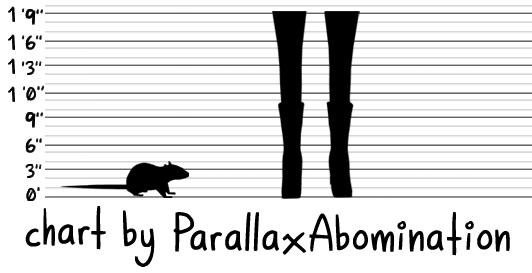For each mechanic, I would like to break down its game loop to show what process the player will be doing:
Height Comparison

Height Comparison between Rats and a 5’6″ human.
A human would be large compared to the Rats, only about 3″ tall. I made a height comparison to show the scale at which I would be working.
Jump
- Up to 10 levels and 2 Paths: High Jumper (Vertical) and Long Jumper (Horizontal).
- The player character can jump up to 26″.
- You can get up to 3 “Jump Bursts” (power-boosted jumps in either direction” in each level.

Swim
- Up to 10 levels and 2 Paths: Treader and Diver
- Treaders can swim up to great distances and Divers can dive up to a certain depth.

Climb
- Up to 10 levels and 2 Paths: The Scaler (High climber) and The Tougher (Able to climb tough surfaces)
- The player character can climb: climbing trees, walls, drain pipes and wires
- The player character cannot climb: Smooth surfaces (glass, metal, and polished wood), Vertical surfaces (without ledges), and Wet or slippery surfaces.

Chew
- Up to 5 levels
- Rats can chew through most materials.
- Rats cannot chew through: Solid Concrete, Stone and Hard Metals such as Steel (unless rusted, then they can)

Waste (Lesser Mechanic)
As a rat, you’ll need to strategically drop pellets when your waste bar gets high. If you don’t remember to drop it, your character will drop pellets on that spot. While outside, this does not matter as much, but during the levels, it is extremely important. If you drop it in an obvious location, humans will be alerted to your presence.

Embedded systems
Embedded systems are present throughout the entire game, and thus do not need their dedicated game loop explanation/diagram.
XP gaining: XP can be gained using your mechanics, such as chewing, jumping, climbing, and swimming. Each mechanic has their own XP system, with unique perks (2 different routes, similar to Stardew). You will see when you have gained XP as “+[number] XP”, and “Level Up!” above your character, and possibly a special animation.
–
Respect: Depending on your actions, you could even try to win the affection of the house you’re infesting by doing tasks for them (unique to each character). This increases “respect”. Respect isn’t a visible system, but you’ll notice its effects through the way characters treat you.
Respect isn’t just a system that happens on levels. When you navigate the world, you can gain the trust of fellow animals. If you get close, you can crash at their place between levels and experience unique dialogues and interactions which will unlock more lore for the characters.
. . .
Energy: Respect and energy can go hand in hand sometimes. The more actions you take, the more you need to rest. Energy will decrease over a slow period. Depending on your actions, you could come out with full energy if you gain respect from the house owners. This will be difficult to do and thus, it will be easy for most players to just go for the easiest option of not doing this.
If you complete the level with neutral/low respect, you’ll leave with half/low energy and have to temporarily sleep outside, which could leave you vulnerable to attacks from outside.
Stealth: You will have a line of UI bar which shows the line of sight of humans and predators. The line will remain low as a default, but as you are in the line of sight of an enemy, it will shoot up. If you are in the immediate sight of an enemy, the bar will seem like its “almost breaking” and it will stay like that until you hide another area.
Due to this, you will need to be careful and stay alert with sound cues and signs of enemies close by. Use your small size to your advantage. In times of pursuit in levels, quickly hide behind common household items like Toasters, Kettles and Coffee Machines to confuse the human. Outside of levels, use objects outside to hide or distract enemies.
Squeaking: As a Rat, you can squeak. You can strategically do this to lure enemies into traps, scare/pull pranks on characters, or just be a menace. The squeak mechanic will aid you in other mechanics such as stealth.